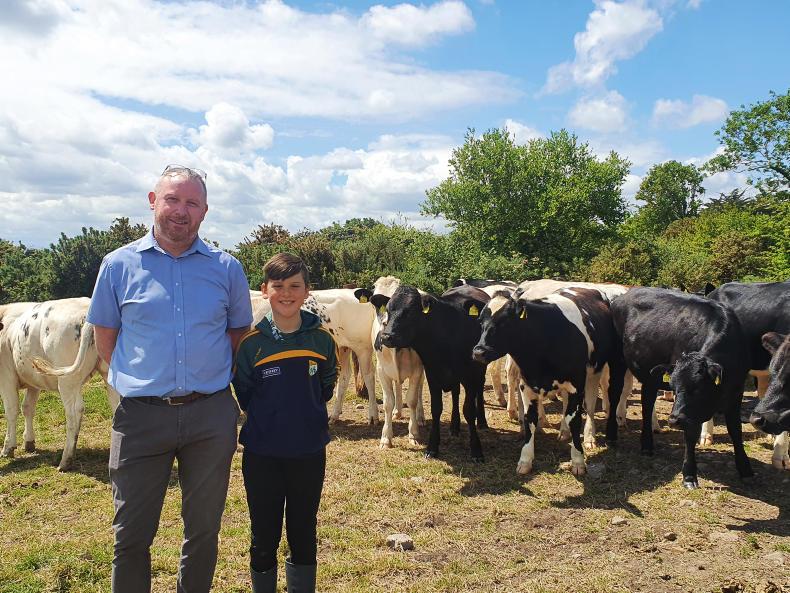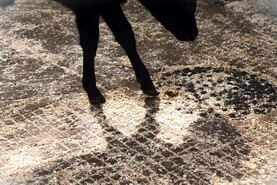John Brosnan farms in Mullaghmarkey, just north of Casteisland, Co Kerry. The farm runs a dairy calf-to-beef system that sees Angus, Hereford and Belgian Blue heifer calves reared on farm and brought through to the end of the second grazing period. John is married to Fiona, and the couple have two children, Ben (10) and Clara (five).
In previous years, John has sold cattle as forward stores, depending on trade and grazing conditions come the back end of the year. The plan at the moment, however, is to bring the 2019-born batch of heifers through to slaughter later this year.
The biggest limiting factor to pushing stock numbers at the moment is winter accommodation
The farm extends to 27ha. At the moment, there are 24 2019-born heifers and 30 2020-born calves on-farm, so there is plenty of scope in terms of stocking rate.
The biggest limiting factor to pushing stock numbers at the moment is winter accommodation, with a four-bay single-slatted shed on-farm capable of providing housing for this year’s 30 weanlings and a few 2019 heifers, should some need to be housed for a short finishing period. There is also an adjoining dry floor shed, where calves are reared each spring.

THRIVE programme farmer John Brosnan with his son Ben.
To get around the shortage of housing space and to make use of the land during the growing season, John sells some fields for silage each year, or if the weather is suitable, he may make some hay for sale.
Rearing
Calf rearing got off to a bad start this year, with one calf lost in the first couple of weeks after arrival. It was caused by a bad case of pneumonia and despite treatment, the calf was lost. Another couple of calves also got a touch of pneumonia around the same time, but they responded to treatment and have fully recovered.
“The calf we lost went down very quickly, we thought we got it early enough but it wasn’t to be. When you see it starting to go through a batch of calves it is worrying, but luckily we got on top of it.

The 2020 batch of calves.
“The calves had received a pneumonia vaccine, but it wasn’t enough to save this calf – but perhaps the problem would have been worse in the rest of the batch had they not been vaccinated.” John said.
After this, the rest of the rearing period went relatively smoothly and despite poor weather in early spring, by the time calves were turned out to grass, the conditions were favourable. The 2020 calf sires are listed in Table 1.
“We have a small paddock at the back of the shed that we let calves out to for a few days, to ease the transition from indoors to outdoors. It also allows us to train them in on the electric fence.”
Grass supply
Given the lower stocking rate, there is no grass supply issue on-farm. This year’s calves are just coming to the end of a paddock that was quite strong, but John was strip grazing it and giving calves access to fresh grass every couple of days.
He was not forcing calves to graze out the stem at the bottom.
The plan is to move them into the field next to this paddock in the coming days, where there is a much lower cover of fresh grass available.
Yearling stock are currently grazing ground that is classified as low-input permanent pasture in the GLAS. This prevents John from cutting or topping the ground until July.
The yearlings have already grazed this ground twice and will graze it once more before the end of June. If needed, John will top the ground after the first grazing in July.

Heifers will be batched for feeding according to slaughter date later in the summer.
“The 2019 calves are doing well, they are happy enough with the grazing they have and they are getting a fresh move every few days.
“We will have silage ground coming back in to the grazing rotation in the next couple of weeks as well, so once that comes in they will be grazing good-quality aftergrass.”
The target is to achieve a 260kg carcase off-grass with as many of the heifers as possible. The plan is to feed 3kg/day meal for six weeks pre-slaughter.
Some of the Belgian Blue heifers may need to be housed for a short finishing period with a slightly higher concentrate feeding level to achieve the required fat specification.
“A lot will depend on the grazing conditions here in autumn. In a good open year, we can graze cattle to late October and into November with no problem – but if it turns wet, it can be difficult.
If that does happen, we will have to look at housing the finishing cattle earlier and holding this year’s calves out until we have sufficient space to house them,” John explained.
Looking at the stock, there is no reason why there shouldn’t be heifers drafted by mid-September.
Ideally, come August time, the batch of finishing heifers should be split up into different groups depending on their target slaughter date.
To hit the target carcase weight, these heifers need to be on the best of grazing for the rest of the year.
If they can average close to 1kg/day on grass alone for the rest of the season and do 1.2-1.25kg/day during the meal feeding period, then there should be no issue hitting the 260kg carcase target.
Improving year-on-year
The challenge for John will then be to set a higher target carcase weight for next year’s finishing cattle. This will be the first year the farm brings these dairy cross cattle through to slaughter and it will be a learning curve. Fine-tuning the system and learning lessons from mistakes along the way is the only way to improve the overall farm enterprise in the future.
John Brosnan farms in Mullaghmarkey, just north of Casteisland, Co Kerry. The farm runs a dairy calf-to-beef system that sees Angus, Hereford and Belgian Blue heifer calves reared on farm and brought through to the end of the second grazing period. John is married to Fiona, and the couple have two children, Ben (10) and Clara (five).
In previous years, John has sold cattle as forward stores, depending on trade and grazing conditions come the back end of the year. The plan at the moment, however, is to bring the 2019-born batch of heifers through to slaughter later this year.
The biggest limiting factor to pushing stock numbers at the moment is winter accommodation
The farm extends to 27ha. At the moment, there are 24 2019-born heifers and 30 2020-born calves on-farm, so there is plenty of scope in terms of stocking rate.
The biggest limiting factor to pushing stock numbers at the moment is winter accommodation, with a four-bay single-slatted shed on-farm capable of providing housing for this year’s 30 weanlings and a few 2019 heifers, should some need to be housed for a short finishing period. There is also an adjoining dry floor shed, where calves are reared each spring.

THRIVE programme farmer John Brosnan with his son Ben.
To get around the shortage of housing space and to make use of the land during the growing season, John sells some fields for silage each year, or if the weather is suitable, he may make some hay for sale.
Rearing
Calf rearing got off to a bad start this year, with one calf lost in the first couple of weeks after arrival. It was caused by a bad case of pneumonia and despite treatment, the calf was lost. Another couple of calves also got a touch of pneumonia around the same time, but they responded to treatment and have fully recovered.
“The calf we lost went down very quickly, we thought we got it early enough but it wasn’t to be. When you see it starting to go through a batch of calves it is worrying, but luckily we got on top of it.

The 2020 batch of calves.
“The calves had received a pneumonia vaccine, but it wasn’t enough to save this calf – but perhaps the problem would have been worse in the rest of the batch had they not been vaccinated.” John said.
After this, the rest of the rearing period went relatively smoothly and despite poor weather in early spring, by the time calves were turned out to grass, the conditions were favourable. The 2020 calf sires are listed in Table 1.
“We have a small paddock at the back of the shed that we let calves out to for a few days, to ease the transition from indoors to outdoors. It also allows us to train them in on the electric fence.”
Grass supply
Given the lower stocking rate, there is no grass supply issue on-farm. This year’s calves are just coming to the end of a paddock that was quite strong, but John was strip grazing it and giving calves access to fresh grass every couple of days.
He was not forcing calves to graze out the stem at the bottom.
The plan is to move them into the field next to this paddock in the coming days, where there is a much lower cover of fresh grass available.
Yearling stock are currently grazing ground that is classified as low-input permanent pasture in the GLAS. This prevents John from cutting or topping the ground until July.
The yearlings have already grazed this ground twice and will graze it once more before the end of June. If needed, John will top the ground after the first grazing in July.

Heifers will be batched for feeding according to slaughter date later in the summer.
“The 2019 calves are doing well, they are happy enough with the grazing they have and they are getting a fresh move every few days.
“We will have silage ground coming back in to the grazing rotation in the next couple of weeks as well, so once that comes in they will be grazing good-quality aftergrass.”
The target is to achieve a 260kg carcase off-grass with as many of the heifers as possible. The plan is to feed 3kg/day meal for six weeks pre-slaughter.
Some of the Belgian Blue heifers may need to be housed for a short finishing period with a slightly higher concentrate feeding level to achieve the required fat specification.
“A lot will depend on the grazing conditions here in autumn. In a good open year, we can graze cattle to late October and into November with no problem – but if it turns wet, it can be difficult.
If that does happen, we will have to look at housing the finishing cattle earlier and holding this year’s calves out until we have sufficient space to house them,” John explained.
Looking at the stock, there is no reason why there shouldn’t be heifers drafted by mid-September.
Ideally, come August time, the batch of finishing heifers should be split up into different groups depending on their target slaughter date.
To hit the target carcase weight, these heifers need to be on the best of grazing for the rest of the year.
If they can average close to 1kg/day on grass alone for the rest of the season and do 1.2-1.25kg/day during the meal feeding period, then there should be no issue hitting the 260kg carcase target.
Improving year-on-year
The challenge for John will then be to set a higher target carcase weight for next year’s finishing cattle. This will be the first year the farm brings these dairy cross cattle through to slaughter and it will be a learning curve. Fine-tuning the system and learning lessons from mistakes along the way is the only way to improve the overall farm enterprise in the future.









 This is a subscriber-only article
This is a subscriber-only article










SHARING OPTIONS: